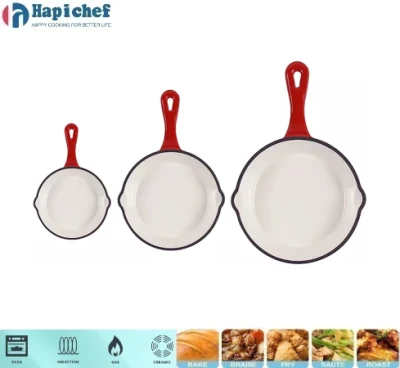Versatile Enameled Cast Iron Skillet for Perfect Cooking Results Every Time
The Versatile Charm of Enameled Cast Iron Skillets
Enameled cast iron skillets have gained significant popularity in recent years, becoming a staple in many kitchens worldwide. These culinary tools blend the durability of cast iron with the elegance of enamel, making them both functional and aesthetically pleasing. Whether you’re an experienced chef or a culinary novice, understanding the benefits and magic of enameled cast iron skillets is essential.
What is Enameled Cast Iron?
Enameled cast iron skillets are made from traditional cast iron that has been coated with a glass enamel glaze. This process provides a smooth, colorful surface that not only enhances the skillet's appearance but also makes it easier to maintain. Unlike raw cast iron, enameled versions do not require seasoning, which makes them more convenient for everyday use.
Advantages of Enameled Cast Iron Skillets
1. Non-Reactive Surface One of the key benefits of enameled cast iron is that its non-reactive surface allows you to cook acidic foods—like tomatoes or vinegar-based dishes—without altering their flavor or damaging the skillet. This is especially important for those who love to experiment with different ingredients in their cooking.
2. Versatility Enameled cast iron skillets can be used on various heat sources, including gas, electric, induction, and even in the oven. This versatility makes them suitable for a wide array of cooking methods, from frying and sautéing to baking and roasting.
3. Excellent Heat Retention Cast iron is renowned for its ability to retain heat, which is essential for achieving that perfect sear on meats or a golden crust on baked goods. Enameled cast iron skillets distribute heat evenly, minimizing hot spots that can lead to uneven cooking.
4. Easy to Clean The smooth enamel surface makes cleaning a breeze. Unlike traditional cast iron skillets that require careful handling, enameled versions can often be cleaned with warm soapy water and a soft sponge. Some skillets are even dishwasher safe, though hand washing is typically recommended to prolong their lifespan.
enameled cast iron skillet

5. Aesthetic Appeal Enameled cast iron skillets come in various colors and designs, allowing you to choose pieces that match your kitchen decor. They can double as serveware, making it easy to transition from stovetop to table without compromising on style.
Cooking Tips with Enameled Cast Iron Skillets
To get the most out of your enameled cast iron skillet, consider the following tips
- Preheat Slowly Enameled cast iron takes time to heat up. Preheat your skillet on low to medium heat to ensure even cooking. - Use Moderate Heat While enameled cast iron retains heat exceptionally well, excessive high heat can damage the enamel. Aim for moderate cooking temperatures for the best results. - Avoid Metal Utensils To prevent scratching the enamel, opt for wooden, silicone, or heat-resistant plastic cooking utensils.
Caring for Your Enameled Cast Iron Skillet
Proper care will keep your skillet looking new for years to come
- Avoid Abrasive Cleaners While the enamel is durable, avoid using steel wool or abrasive cleaners that can scratch the surface. - Store with Care If stacking your skillets, place a soft cloth or paper towel between them to prevent scratching. - Check for Chips Inspect the skillet regularly for any chips or cracks, as these can lead to rust over time. If you notice any damage, it may be time to replace your skillet to ensure safe cooking.
Conclusion
Enameled cast iron skillets are a perfect combination of beauty and functionality, making them a must-have in any kitchen. Their unique properties allow you to tackle a variety of recipes while enjoying ease of use and maintenance. Whether you’re cooking a hearty stew, baking cornbread, or searing vegetables, an enameled cast iron skillet can elevate your culinary experience. Invest in one of these versatile beauties, and you’ll discover just how delightful cooking can be.
-
hapichefs-casserole-cast-iron-cookware-symphonyNewsAug.23,2025
-
casserole-cast-iron-cookware-in-a-modern-art-installationNewsAug.23,2025
-
hapichefs-molten-artistry-portable-cast-iron-bbq-grill-birthNewsAug.23,2025
-
forging-flavor-in-acast-iron-bbq-grills-fireNewsAug.23,2025
-
hapichefs-enameled-cast-iron-bakeware-a-chefs-museNewsAug.23,2025
-
why-colorful-enameled-cast-iron-bakeware-improves-meal-tasteNewsAug.23,2025
-
Unleash Your Culinary Creativity with Specialized Roasting and Baking PansNewsAug.20,2025
